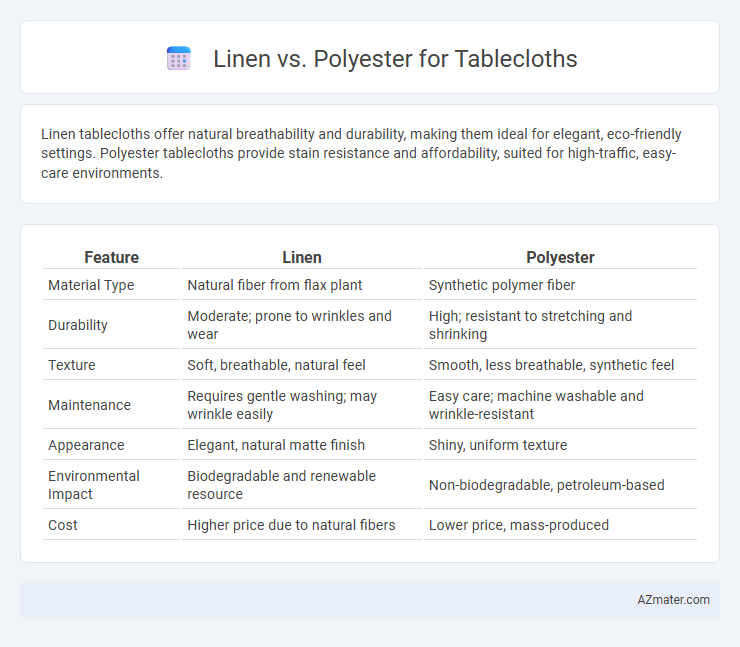Linen tablecloths offer natural breathability and durability, making them ideal for elegant, eco-friendly settings. Polyester tablecloths provide stain resistance and affordability, suited for high-traffic, easy-care environments.
Table of Comparison
| Feature | Linen | Polyester |
|---|---|---|
| Material Type | Natural fiber from flax plant | Synthetic polymer fiber |
| Durability | Moderate; prone to wrinkles and wear | High; resistant to stretching and shrinking |
| Texture | Soft, breathable, natural feel | Smooth, less breathable, synthetic feel |
| Maintenance | Requires gentle washing; may wrinkle easily | Easy care; machine washable and wrinkle-resistant |
| Appearance | Elegant, natural matte finish | Shiny, uniform texture |
| Environmental Impact | Biodegradable and renewable resource | Non-biodegradable, petroleum-based |
| Cost | Higher price due to natural fibers | Lower price, mass-produced |
Introduction to Linen and Polyester Tablecloths
Linen tablecloths, made from flax fibers, offer a natural, breathable, and textured surface known for durability and elegance, ideal for both casual and formal dining settings. Polyester tablecloths, crafted from synthetic polymers, provide wrinkle resistance, stain repellency, and easy maintenance, making them a practical choice for everyday use and commercial applications. Both materials vary significantly in feel, appearance, and care requirements, influencing their suitability for different table settings.
Material Composition and Properties
Linen tablecloths, made from natural flax fibers, offer breathability, moisture-wicking properties, and a textured, elegant appearance that softens with washing. Polyester tablecloths consist of synthetic fibers, providing durability, wrinkle resistance, and stain-proof qualities that make them low-maintenance and ideal for frequent use. The choice between linen's eco-friendly, premium feel and polyester's practical, long-lasting performance depends on the desired balance of aesthetics and functionality.
Aesthetic Appeal and Texture
Linen tablecloths offer a natural, elegant aesthetic with a slightly textured, breathable fabric that enhances rustic and sophisticated dining settings. Polyester tablecloths provide a smoother, more uniform appearance with a slight sheen, ideal for modern or formal occasions requiring easy maintenance. The tactile contrast between linen's coarse, organic feel and polyester's silky, wrinkle-resistant surface influences the overall table presentation and ambiance.
Durability and Longevity
Linen tablecloths offer exceptional durability due to their natural fiber composition, becoming softer and stronger with each wash and resisting wear over time. Polyester tablecloths provide high resistance to wrinkles, stains, and everyday use, maintaining their appearance longer without significant fading or fraying. While linen excels in longevity through natural strength and breathability, polyester outperforms in low-maintenance durability and color retention for frequent use.
Stain Resistance and Ease of Cleaning
Linen tablecloths offer a natural, breathable fabric but are more prone to staining and require gentle washing to maintain their texture and appearance. Polyester tablecloths provide superior stain resistance due to their synthetic fibers, allowing for easy cleaning with most household detergents and better durability against spills and frequent washing. Choosing polyester ensures a low-maintenance option ideal for high-traffic dining settings, while linen requires more careful handling to preserve its aesthetic.
Environmental Impact and Sustainability
Linen tablecloths are made from flax fibers, a renewable resource that requires less water and pesticides compared to cotton and synthetic fabrics, making them biodegradable and environmentally friendly. Polyester tablecloths, derived from petroleum-based products, contribute to microplastic pollution and have a higher carbon footprint due to energy-intensive production processes. Choosing linen supports sustainable agriculture and reduces waste, while polyester often leads to longer-lasting durability but at significant ecological cost.
Cost Comparison: Linen vs Polyester
Linen tablecloths typically cost between $30 to $100 per yard due to the natural fibers and labor-intensive production, reflecting their premium quality and durability. Polyester tablecloths are significantly more affordable, ranging from $5 to $20 per yard, offering budget-friendly options with stain resistance and easy maintenance. The price premium of linen reflects its breathable texture and elegance, while polyester provides economical versatility for casual or high-traffic use.
Comfort and Feel on the Table
Linen tablecloths offer a natural, breathable fabric with a soft yet textured feel that enhances the tactile experience on the table. Polyester tablecloths provide a smoother, less breathable surface with a slightly synthetic touch that resists wrinkles and stains but lacks the organic warmth of linen. Overall, linen excels in comfort and authenticity, while polyester prioritizes durability and easy maintenance.
Best Uses and Occasions
Linen tablecloths offer a natural, breathable fabric ideal for elegant dining events, weddings, and outdoor summer parties due to their moisture-wicking properties and sophisticated texture. Polyester tablecloths excel in durability and stain resistance, making them suitable for everyday use, casual gatherings, and commercial settings like restaurants or banquet halls. Choosing between linen and polyester depends on the need for luxury and breathability versus practicality and ease of maintenance.
Final Verdict: Choosing the Right Tablecloth Material
Linen tablecloths offer natural breathability, luxurious texture, and durability, making them ideal for formal or eco-conscious settings, while polyester excels in stain resistance, easy maintenance, and affordability for everyday use. The final verdict depends on prioritizing elegant aesthetics and sustainability with linen versus practical convenience and budget-friendly longevity with polyester. Selecting the right tablecloth material hinges on balancing the desired appearance, care requirements, and intended usage environment.

Infographic: Linen vs Polyester for Tablecloth
 azmater.com
azmater.com